| Government Agency overview | |
|---|---|
| Jurisdiction | Victoria, Australia |
| Parent department | Department of Transport and Planning |
| Website | https://transportsafety.vic.gov.au/ |
The Director, Transport Safety, who operates as Transport Safety Victoria, is the independent Government agency responsible for bus and marine safety in the State of Victoria, Australia. The position was created as a statutory office by the Transport Integration Act 2010 and the office commenced operation on 1 July 2010. The Rail branch of TSV completed transfer to the Office of the National Rail Safety Regulator (ONRSR) in December 2019.
The Director, Transport Safety is one of two dedicated transport safety offices in Victoria, [1] the other being the Chief Investigator, Transport Safety. The Director has oversight of safety regulation schemes and industry performance under the schemes and is responsible for regulation and compliance activities in the transport sector, while the Chief Investigator conducts no blame or just culture investigations and inquiries in the transport sector. These agencies are part of the Department of Transport but are functionally independent and report to the relevant Ministers. [2]
The Director is also responsible for the safety regulation of bus services in Melbourne and wider Victoria (large public buses are generally operated in Victoria by a wide variety of bus operators under contract with Public Transport Victoria) including mini bus operators. Power is derived from the Bus Safety Act 2009 .
The Director is the safety regulator of recreational boating in Victoria. The monitoring of recreational craft covers the regulation of a wide range of vessels including yachts, speedboats, jet skis, canoes and paddle boats. The Director's jurisdiction to regulate boating predominately arises under the Marine Safety Act 2010 although some powers are exercised under delegation founded under Commonwealth legislation. The commercial sector is regulated by the Australian Maritime Safety Authority (AMSA).
The office of the Director, Transport Safety was established after the passage and commencement of the Transport Integration Act 2010. The office arose from the amalgamation of the offices of the Director, Public Transport Safety [3] [4] and the Director of Marine Safety. [5] This resulted in Victoria's first integrated transport safety administration with multi modal responsibilities in land and water-based transport.
The relevant Minister in the Victorian Parliament put the matter as follows:
The Transport Integration Act provides the Director, Transport Safety with a governance framework - the objects, functions and powers - which comprise the charter of the office.
The Transport Integration Act provides that the primary object of the Director, Transport Safety is to "...independently seek the highest transport safety standards that are reasonably practicable...". [7] Other notable objects [8] of the Director include:
The functions [9] of the Director, Transport Safety include:
The Transport Integration Act provides the Director, Transport Safety with a range of general powers [10] which can be exercised in relation to the bus and marine industries. More specific powers are contained in the key statutes administered by the Director, namely the Bus Safety Act 2009 and the Marine Safety Act 1988. Supporting compliance powers are established in the Transport (Compliance and Miscellaneous) Act 1983 for the bus industry. [11]
The compliance support scheme enables the appointment of authorised officers and confers coercive powers and a range of administrative and court-based sanctions. The key elements are:
The powers of the Director in the marine sector under the Marine Act 1988 cover many of the areas listed above.
The Director is independent of Ministers and Government generally. The Transport Integration Act provides, for example, that the Director "...when performing or exercising his or her functions, is independent and is not subject to the direction and control of the Minister." [17] Independence is supported by provisions requiring that the removal of the Director from office can only occur with the approval of both Houses of Parliament. [18]
Many of the responsibilities of the Director center on monitoring and enforcing industry compliance with safety standards established by legislation. Examples of the Director's responsibilities are set out below.
The Bus Safety Act 2009 regulates the operation safety of large and small buses in Victoria. The Act imposes safety duties on bus operators and all others who have a role in providing both commercial and non-commercial bus services. [19] It does this by -
The Act also establishes an accreditation scheme for the operators of larger buses. [20] Operators of smaller buses or buses not used commercially are subject to a lower impact registration requirement.
The Marine Safety Act 2010 establishes a range of permissioning schemes for commercial vessels and recreational vessels and their operators and crew. The Marine Drug, Alcohol and Pollution Control) Act 1988 also establishes a scheme to control drug and alcohol use when in charge of a vessel [21] and provisions prohibiting and controlling marine pollution in Victoria. [22]
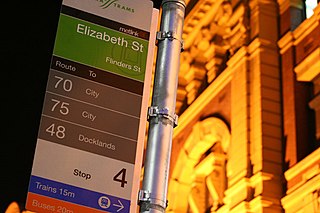
Metlink was the marketing body and umbrella brand for public train, tram and bus transport operators in Melbourne, Australia. On 2 April 2012, the operations of Metlink were transferred to the newly created public transport planning and management authority, Public Transport Victoria.

Yarra Trams is the trading name of the operator of the tram network in Melbourne, Australia, which is owned by VicTrack and leased to Yarra Trams by the Victorian Department of Transport and Planning. The current franchise is operated by Keolis Downer. As at May 2014, Yarra Trams operate 487 trams, across 26 tram routes and a free City Circle tourist tram, over 1,763 tram stops. With 250 km (155.3 mi) of double track, Melbourne's tram network is the largest in the world.
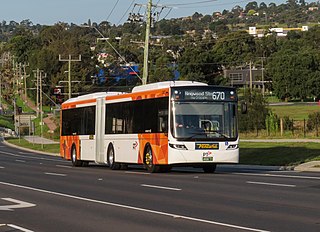
Buses in Melbourne, Australia, are a major form of public transport in Melbourne, with an extensive bus network. There are 346 routes in operation with a varying range of service frequencies, operated by privately owned bus companies under franchise from the State Government. The Night Network bus system consists of 10 routes and operates on Friday and Saturday nights, and a SmartBus orbital bus network currently consisting of nine routes, which is intended to facilitate cross city travel, while the current network is predominantly a radial network. Most of the bus network is a covered by the myki ticketing system.
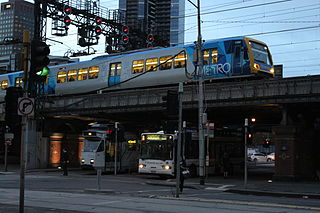
Transport in Melbourne, the state capital of Victoria, Australia, consists of several interlinking modes. Melbourne is a hub for intercity, intracity and regional travel. Road-based transport accounts for most trips across many parts of the city, facilitated by Australia's largest freeway network. Public transport, including the world's largest tram network, trains and buses, also forms a key part of the transport system. Other dominant modes include walking, cycling and commercial-passenger vehicle services such as taxis.
VicRoads is a government joint venture in the state of Victoria, Australia. In the state, it is responsible for driver licensing and vehicle registration. It is owned and operated through a joint venture between the Victorian government and a consortium made up of Aware Super, Australian Retirement Trust and Macquarie Asset Management.
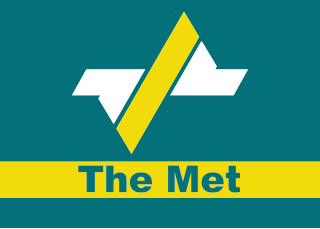
The Public Transport Corporation (PTC) was a Victoria State Government owned statutory authority formed under the Transport Act 1983 which operated passenger and freight trains, trams and bus services.

The Transport Integration Act 2010 is a law enacted by the Parliament of the State of Victoria, Australia. The Act is the prime transport statute in Victoria, having replaced major parts of the Transport Act 1983, which was renamed as the Transport Act 1983.

The Transport Legislation Review is a policy and legislation review project conducted by the Department of Transport in the State of Victoria, Australia between 2004 and late 2010. The aim of the project was review of transport policy and laws and generation of new policy and legislation as a platform for better transport across the State.

The Department of Transport (DOT) was the government agency responsible for the coordination, integration and regulation of the transport system in the State of Victoria, Australia. The department generated planning, policy, and legislation for transport in Victoria. As a result, the department drove the integration of Victoria's transport land and water transport systems and the delivery of public transport, road and port services and associated activities across the State. The department's stated mission was "Building a safer, fairer and greener transport system for all Victorians to create a more prosperous and connected community."

The Rail Safety Act 2006 is a law enacted by the Parliament of the State of Victoria, Australia, and is the prime statute regulating the safety of rail operations in Victoria. The Act was developed as part of the Transport Legislation Review conducted by the Department of Transport between 2004 and 2010 and is aimed at preventing deaths and injuries arising from rail operations.

The Director of Public Transport was the head of the Public Transport Division (PTD) of the Victorian Department of Transport. PTD was the government agency responsible for promoting, providing, coordinating and regulating public transport in the state of Victoria, Australia between August 1999 and June 2013. The Director of Public Transport was created as a statutory office supported by staff of the Department of Transport.

The Tourist and Heritage Railways Act 2010 is a law enacted by the Parliament of the State of Victoria, Australia and is the prime statute regulating the activities of tourist and heritage rail operators in the State. The Act covers the bulk of Victoria's operational tourist and heritage railways including many heavy and light rail operations and tramways, predominantly in regional areas of Victoria.
The Director, Public Transport Safety was the independent Government agency responsible for rail and bus safety in the State of Victoria, Australia, between 1 August 2006 and 30 June 2010. The position was created as a statutory office by statute in early 2006 and was the State's first independent public transport safety position. The office was superseded by the position of the Director, Transport Safety which commenced operation on 1 July 2010. The former Safety Director, Public Transport Safety, Alan Osborne, was directly appointed to the new office.
The Chief Investigator, Transport Safety is the independent Government agency responsible for investigation of safety-related trends and incidents in the rail, bus and marine industries in the State of Victoria, Australia.
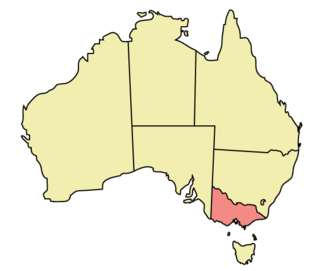
The Accident Towing Services Act 2007 is a law enacted by the Parliament of the State of Victoria, Australia. The act is the prime statute regulating the vehicle towing industry which provides towing and recovery services for light and heavy road vehicles across Victoria. It is predominately founded on safety and consumer protection sentiments. The act continued economic controls over the industry and contains occupational regulation characteristics. The style of the underlying regulatory scheme varies in parts and represents a blend which is prescriptive in some parts and performance and process-based in others.

The Bus Safety Act 2009 is a law enacted by the Parliament of the State of Victoria, Australia and is the prime statute regulating the safety of bus operations in Victoria. The Act was developed as part of the Transport Legislation Review conducted by the Department of Transport between 2004 and 2010 and is aimed at preventing deaths and injuries arising from bus operations in Victoria and establishes a modern "best practice" regulatory framework to assist in maintaining and improving the Victorian bus industry's good safety record.

Commercial Passenger Vehicles Victoria (CPVV), until 2 June 2018 called the Taxi Services Commission (TSC), is the Government agency responsible for the regulation of the taxi and hire car industries in the State of Victoria, Australia. Before becoming a regulator, the TSC was responsible for conducting a major independent inquiry, the Taxi Industry Inquiry, into taxi and other small commercial passenger vehicle services in the State.
The Transport Legislation Amendment Act 2011 is a law enacted by the Parliament of the State of Victoria, Australia to reform taxi and other small commercial passenger vehicle services in the State.
The Transport Act 1983 was the main statute establishing government transport organisations and regulating land transport activities in the State of Victoria, Australia for 27 years from mid-1983 to mid-2010. The act was used as the vehicle for changes to transport organisational arrangements and transport regulation activities pursued by Victorian governments over that period.

The Transport Act 1983 is a prime statute regulating transport activities in the State of Victoria, Australia. Key areas regulated by the statute currently include taxi and hire car services and compliance and enforcement, particularly in areas like safety and public transport ticketing and conduct.